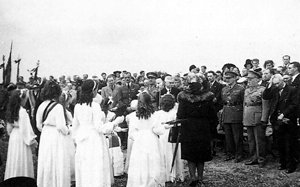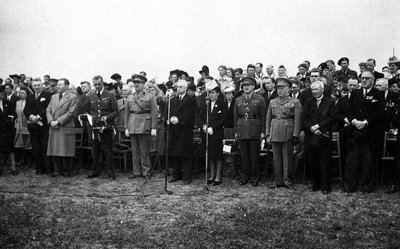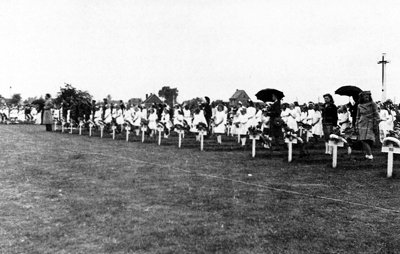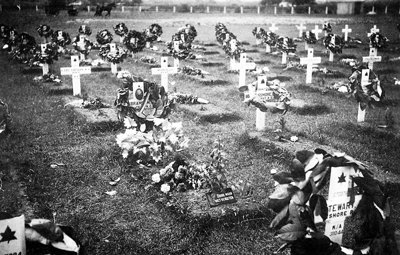The first Canada Day
- 16 june 1946 -
The first official Canadian ceremony of 16 June 1946 was preceded by yet another one, namely a tribute to the Grenadiers who fell in May 1940. It were "la Grenade" and "Le Colis du Grenadier" who paid them homage. The town council was "very honoured and happy to be permitted to collaborate in this tribute to the dear heroes who with their precious blood bought freedom for our fatherland." We mention this commemoration because a military delegation, accompanied by the Governor of East-Flanders, went to lay a wreath in the Canadian cemetery. "This would not be an offical tribute because within fourteen days in a great ceremony, tribute would be paid to the Canadian heroes killed in action by the mediation of the Welfare and with the collaboration of the town council." Even though this was not an official homage it grew in dignity and grandeur and the flower tributes kept coming..
Preparations

As a preparation for the Canadian ceremony Maria De Keyser took some earth from every grave to be presented later to Ambassador Turgeon.
As we already wrote it was Mrs le Clément de Saint-Marcq who as president of the Welfare of Ghent came forward with the proposal to organize an official commemoration ceremony in the Adegem War Cemetery. She personally discussed it all with the town council and from Ghent almost singlehandedly took care of the organization and the preparations.
Mrs. le Clément de Saint-Marcq so effectively communicated her enthusiasm for this tribute that she succeeded in mobilizing practically the whole Meetjesland.
The first pilgrimage was organized very professionally. The press release was sent to every newspaper and most of them quoted it in its entirety:
"Belgo-Canadian day at the Adegem cemetery
A ceremony on the graves, in commemoration of the Canadian soldiers who heroically died for the liberation of our province, will be held on Sunday 16 June 1946 in the Adegem Cemetery (near Eeklo) with the patronage of the "Welfare of Ghent".
A hopeful call was addressed to the Belgian women to ask them to participate in great numbers in this pilgrimage. They will do everything possible to replace wholeheartedly and with dedication the mothers, wives, daughters, sisters and Canadian fiancees who couldn't make the trip overseas to lovingly bow over the grave of their loved ones who freely sacrificed their young lives so we might live free.
We maintain that their last resting place will be supplied with lots of flowers and that every grave will be honored with a flower and a prayer.
The civilian and military authorities, all the patriotic associations, the War Veterans and those who were active in the Resistance, the schools of the province will not fail to send a delegation to take part and to show their recognition in this great manifestation and homage.
For further information please contact the "Welfare of Ghent", Koophandelsplein, 11, Ghent, between 11 hrs and 12:15."

Poster of the first official Canadanian ceremony, organized by the 'Welfare' of Ghent.
Not only were there articles in the newspapers, there were also the posters distributed everywhere. And there were special trains; and busses from Ghent with reserved seats. Nothing was left to chance.
Adegem town itself also put up a good show. Even if the town council was not the organizer, it gave all possible logistic support. Constable Albert Notteboom for instance did everything possible to help the people of Ghent. There was also help from private citizens, for instance Maria De Keyser, whom one could always call upon for the solution to little practical problems: for making the wreathes which the school children would put on the graves, for inviting certains persons, for contacting local associations, etc. Miss Yvonne De Schepper, retired school teacher of the girls' school told us it was the De Keyser family that took the Canada day to heart. They provided everything needed for the wreathes which the pupils in the girls' school then made. This proved to be such a long and arduous task for the girls that it was stopped after two years, always according to Miss De Schepper.
The local patriotic associations "Eendracht maakt Macht" (Concord means Power, L'Union fait la Force), Old Brothers in Arms, War Veterans 1914-18, 1940-1945 even organized a lottery in 1946 "to cover the costs for adding lustre to the numerous tributes in the cemetery of the soldiers who fell on Adegem's soil and in the Canadian Cemetery where so many Canadian and Polish soldiers lay buried."
In Adegem Mrs. le Clément de Saint-Marcq never asked in vain. Again and again her enthusiasm and convincing arguments moved mountains. The town council even set aside a credit of 10,000 francs to finance this celebration and the one of 26 May: "Considering that on 16 June a Belgo-Canadian day will be organized by the 'Welfare' when his Excellency the Embassador of Canada and other high dignatories will be present, and the town council will have to take care of the reception in the town hall, of the arrangements in the cemetery, of installing seats, of erecting an altar and of the purchase of a wreath. Considering that the population here will express its recognition to the Canadian heroes and friends, which will mean certain heavy expenses."
The pilgrimage
The ceremony began at 9:45 a.m. with the reception of the civil, military and religious authorities in the town hall, as mentioned in the program. Burgomaster Leopold Van Waetermeulen welcomed everyone. The Canadian Embassador, Mr. W.F.A. Turgeon received a very special thank you for his honored presence. During this reception in the town hall a cortege was formed in the town center which around 10 o'clock started for the Prince Baldwin Lane. About a thousand children from East and West Flanders (200 had come over from Ghent alone), dozens of war veterans and men of the Resistance with their colourful banners, six musical bands, servicemen and civilians marched in orderly rows to the Canadian cemetery where the guests arrived at 10:30. By now it was raining heavily.
Major Cameron, a Protestant army chaplain, quoted from the Book of Wisdom and shed light on the heroic sacrifice of the young Canadians.
With hundreds of wreaths the VIPs present, the participating associations and groups laid an endless floral tribute full of piety on the foot of what was then still the wooden cross of sacrifice. School children laid a symbolic wreath of maple leaves on each grave. After a short speech by Mrs. le Clément de Saint-Marcq hundreds of little bags of earth were handed over to Ambassador Turgeon, as many as the number of buried Canadians. The ambassador was touched. He thanked everyone and promised the bags would get to the respective families. The school children sang "0 Canada! Terre de nos Aïeux" which was one of the high points of the ceremony that moved all Canadians present.
At 11:30 Herman Van Damme, the village priest, assisted by chaplains Goethals, Tessiers and two others the solemn open air Mass under threatening clouds. The choir of the Saint-Gregorius Guild of Eeklo together with the Boys Choir of the Brother of Charity sang the three-part Mass of De Boeck. The "Libera Me" by Jules Verhasselt was sung impeccably.
A strong wind blew up when time came for the consecration. All the flags fluttered and the rain came pouring down. "The ladies fled like hares, maidens ran for cover under mother's coat or umbrella. What a pity everything fell to pieces" wrote the Eecloonaer. The Mass was quickly continued. Between two showers the priest yet managed to consecrate the cemetery.
After the Belgian and English National Anthems the guests hurriedly left and the soaked crowds cleared off. The rain had done its worst.
The participants

During the ceremony of 16 June 1946 in the cemetery an open air Mass was celebrated by no less than five priests. Unfortunately everything was disfigured by the heavy rains: carpets, cushions and frabics, everything was drenched. No costs and efforts were spared, for instance also for the sound system and loudspeakers.
More than 200 flags of as many patriotic associations stood around the altar.

Besides the Gregorius Guild from Eeklo the Adegem church choir was also present to add lustre to the ceremony in the cemetery. At the foot of the cross they sang "Towards the Future" (Vers l'Avenir) and at the end of the ceremony they sang "O Canada". We recognize (from left to right) Alfons De Baets, Albert De Kesel, Jozef De Keyser, Leon Van de Velde, Jozef De Baets, constable Albert Notteboom, Camiel Sierens, August Notteboom, Willy Bral, vicar Urbain Haes and Herman Van Damme, the village priest.
There were many many school children and ordinary people at this first official ceremony but the following prominent figures and associations also took part:
W.F.A Turgeon, Canadian Ambassador,
d' Arcy McGreer, embassy council,
Cadieux, secretary of the embassy
Kapitein Cardinal, militair attaché of the embassy,
Major Cameron, chaplain,
Major Tessiers, chaplain
Lt.-col. Helpen, commander of the English garrison in Ghent
Greensel I, wing-commander
Watling, representing the RAF
Brigadier Connelly, commander of the Canadese forces
Frank Puaux, consul of France
Major Amelot, representing the Minister of Defense
Colonel De Smet, commandant of the province
Vander Stegen, burgomaster of Ghent
Anseele, alderman of Ghent city and Member of Parliament
Verhelst, alderman of Ghent city
General de Wulf
Lesseliers, representing U.F.A.C.
Garnier, commander of the gendarmerie
Veterans' Associations of Adegem, Eeklo and Maldegem
Political prisoners of several towns
Resistance fighters
gravely war handicapped persons
demobilised Canadian soldiers
the Red Cross
Farmers' Associations of Maldegem and Adegem
Amical des Officiers Canadiens
Scouts Ghent
United Friends (Verenigde Vrienden), Adegem
Saint-Cecilia, Maldegem
Welfare and Entertainment (Nut en Vermaak), Maldegem
Amicitia, Eeklo
Saint-Cecilia ,Eeklo
K.S.A. Band, Eeklo
Schools of Ghent, Eeklo, Maldegem, Adegem and Sint-Laureins

Nine girls dressed all in white with palm branches in their hands as a symbol of the sacrifice of the soldiers and with boxes of earth from the cemetery, march to the central cross of sacrifice led by Maria De Keyser.

Ambassador Turgeon received from the hands of a group of Adegem girls a few hundred bags of earth of the graves of fallen Canadians. The bags were later symbollically dropped in the sea.

For the first official ceremony, organized by the "Welfare" of Ghent with support from the Adegem town council numerous prominent figures were invited. In the middle of this picutre we see Mrs. le Clément de Saint-Marcq who organized the ceremony. On her left we see W.F.A. Turgeon, special plenipotentiary Canadian Ambassador.
Response
"The long forseen ceremony in the Adegem cemetery where a thousand Canadian heroes found their last resting place, took place on Sunday 11 inst. An unheard of mass of people from the whole region had come together in a gesture of gratitude for those who in our land paid with their life to liberate our country", we read in "Free Maldegem" of 23 June 1946.
Many newspapers and weeklies paid special attention to the ceremony. In "Free Maldegem" quoted earlier all prominent figures and associations are listed. And then we read as follows: "The small town of Adegem was the starting point for a mile long parade. Our young people marched quietly in gratitude. It was as if this procession had no end. Ever and ever the participants streamed into the enclosure of the cemetery. When everyone had taken up his position the weather turned sour because it soon started to rain. The school children, boys and girls accompanied by their masters and mistresses were the elite. The wreath hung on every grave was sober but striking. The flowers and wreaths of the participants were piled up around the big heroes cross. During the ceremony the well trained Adegem band played "God save the King", the Belgian anthem and "Far and wide". A Protestant minister gave a sermon in English and then Mrs. le Clément de Saint Marcq spoke in Dutch and in French. The Canadian Ambassador, his Excellency W.F.A. Turgeon then received from innocent childrens hands the little bags that held a little earth from the soldiers graves.
At last the Reverend Van Damme assisted by four foreign priests, former political prisoners began the Holy Mass. During the consecration a storm so violent broke loose that people might be forced to leave the cemetery. But no, most of them preferred to be wet... the ceremony wasn't finished yet...
The Saint-Gregorius Guild from Eeklo sang the three-part mass by August De Boeck under the direction of Mr. H. Verhasselt. The "Pie Jesu" and the "Libera Me" could not be heard by the crowd because of the continuing bad weather."
The national newspapers didn't fail to mention the ceremony. "Impressive tribute to the dead in the Canadian cemetery at Adegem" was the title of "Het Volk" (The People) of 16 June 1946. "The big Canadian cemetery of Adegem along the road from Ghent to Bruges yesterday witnessed an impressive mourning service for the memory of the thousands of Canadian heroes who gave their blood for the liberation of our territory and have their last resting place in the valleys of Adegem" said the reporter on duty. He concluded the the pilgrimage had become a "dignified tribute to the Canadian heroes who fell for our liberation".

Behind each grave a girl had taken place with a laurel wreath that that had been made in of the schools. Rain was once again the great spoilsport.
The newspaper 'De Gentenaar' of 17 June 1946 described the commemoration as "a grand tribute in which an unheard of number of pilgrims and sympathizers took part, a true demonstration of the real feelings of the population."
'Vooruit' (Forward) published by far the longest and best report. Under the heading "A grand tribute at Adegem" followed a very detailled description of the whole event, whereby "the otherwise so quiet Adegem was overwhelmed with hundreds of school children, veterans, Resistants, deportees, etc." "Homage will be paid to the more than 800 young Canadian soldiers who in the autumn of 1944 sacrificied their beautiful young lives for the liberation of our provinces and for the destruction of the fascist monster because of their terrible ordeal: they died so we might live as free men." The report repeatedly stressed the past events were the fault of the criminal nazism that by its horrible occupation and dishonoring regime had lost the just fight. 'Vooruit' had nothing but praise for the dignified tribute of a courageous people to its courageous liberators.
In 'La Flandre Libérale' Alice Sauton wrote a somewhat romanticized report. Adegem was inundated with "a huge crowd in their Sunday best circulating among the uniforms. From Ghent and from the far corners of the province busses, cars and trucks kept bringing an immense crouwd, laden with flowers. They all wanted to be there for this moving manifestation of remembrance and recognition towards the Canadians forever asleep in our Flanders garden." ("une foule endimanchée circulait melée aux uniformes. De Gand et de tous les coins de la province, des cars, des camions, des voitures amenaient sans cesse une foule immense, chargée de fleurs, qui tenait à s'associer à l' émouvante manifestation de souvenir et de reconnaissance envers les Canadiens endormis à jamais dans notre jardin de Flandre.") The report scarcely mentioned the rain that created all the havoc. On the contrary, the rising wind at the consecration, the flags that suddenly started to flutter were (almost) seen as a sign from God. Sauton described the end of the ceremony as follows: "The crowds ebb away, it's all over, and it all continues. Peace returns to the big cemetery with its flowers, its birds and the loyal memories that will never stop the wake over the doors 'aere perennius'." ( "La foule s'écoule, tout est fini, et tout continue. Le grand cimetière retourne à la paix, parmi ses fleurs, ses oiseaux, et le souvenir fidèle qui ne cessera de veiller sur ses ports 'aere perennius'.")
Words of gratitude

A photograph graces the grave of Sgt. R. William Abramson, killed on 1.11.1944 aged 26 next to the flowers and laurel wreath. "Dead but not forgotten" is the caption. Little by little the relatives now come to see the graves.
Later on all those who had cooperated were personally thanked by Mrs. le Clément de Saint-Marcq. Constable Albert Notteboom, who had given his all for the success of the whole ceremony, received the following letter:
"Sir,
We have the honor to thank you for your cooperation in the organization of the manifestation that took place in Adegem on Sunday 16 June last for the commemoration in the Canadian cemetery.
You have performed your task to everyone's satisfaction with friendliness and courtesy.
With this word of thanks we remain yours faithfully.
The president of 'Ghent Welfare'."


